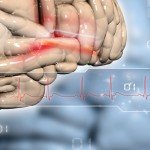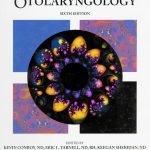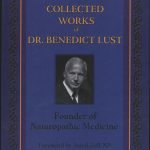Book Review: Anxiety: Orthomolecular Diagnosis and Treatment
Stacie Deyglio, ND
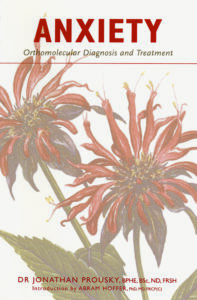 Anxiety disorders are prevalent in our society, affecting about 40 million American adults each year. Jonathan Prousky’s book, “Anxiety: Orthomolecular Diagnosis and Treatment,” is the first of its kind, addressing the diagnosis and treatment of anxiety disorders from an orthomolecular approach.
Anxiety disorders are prevalent in our society, affecting about 40 million American adults each year. Jonathan Prousky’s book, “Anxiety: Orthomolecular Diagnosis and Treatment,” is the first of its kind, addressing the diagnosis and treatment of anxiety disorders from an orthomolecular approach.
Orthomolecular, as defined by Stedman’s Concise Medical Dictionary, is “a therapeutic approach designed to provide an optimum molecular environment for body functions with particular reference to the optimum concentrations of substances normally present in the body” (Dirckx, 1997, p. 630). The original idea of orthomolecular medicine was founded in the late 1960s by Linus Pauling, in his pioneering article on orthomolecular psychiatry. In his book, Prousky follows Dr. Pauling’s scientific basis of orthomolecular medicine and relates its core knowledge to the orthomolecular diagnosis and treatment of anxiety disorders: “With sufficient treatment time, the net result of the orthomolecular approach would be to dampen the autonomic nervous system and facilitate tuning plasticity, thereby improving symptoms of anxiety significantly” (Prousky, p. 123).
The content of Prousky’s book links anxiety to inadequate diet and food allergy. In doing so, he correlates the important aspect of addressing clinical nutrition to the symptom picture of an anxious patient. Given that anxiety is one of the first symptoms of many B-vitamin deficiencies, this book emphasizes the Tolle Causam principle of naturopathic medicine. By identifying and treating the underlying cause of anxiety, patient symptoms may be healed rather than suppressed: “In my practice, the orthomolecular approach has proven to be restorative when treating patients who suffer with debilitating anxiety” (Prousky, p. 8).
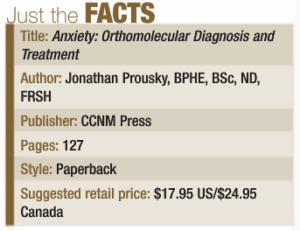 The chapters of the book are allotted into elements of succession. This begins with the psychology and physiology of anxiety disorders, and continues into the standard (allopathic) diagnosis and treatment of anxiety disorders. Orthomolecular diagnosis of anxiety disorders ensues and is followed by individual chapter devotion of the treatment of anxiety disorders using vitamin B3, B12, minerals, essential fatty acids, inositol and amino acids, respectively. The final two chapters are devoted to treating specific anxiety disorders as they occur related to cerebral allergy and hypoglycemia. Each chapter culminates with an evidence-based summary that verifies the body of medical literature existing in support of the orthomolecular treatment of anxiety.
The chapters of the book are allotted into elements of succession. This begins with the psychology and physiology of anxiety disorders, and continues into the standard (allopathic) diagnosis and treatment of anxiety disorders. Orthomolecular diagnosis of anxiety disorders ensues and is followed by individual chapter devotion of the treatment of anxiety disorders using vitamin B3, B12, minerals, essential fatty acids, inositol and amino acids, respectively. The final two chapters are devoted to treating specific anxiety disorders as they occur related to cerebral allergy and hypoglycemia. Each chapter culminates with an evidence-based summary that verifies the body of medical literature existing in support of the orthomolecular treatment of anxiety.
Reference
Dirckx J (ed): Stedman’s Concise Medical Dictionary for the Health Professions Baltimore, 1997, Williams & Wilkins.
 Stacie Deyglio, ND, received her baccalaureate degree in biology with a minor in chemistry from the College of Mt. St. Vincent in NY. Personal health issues paved her way to discover naturopathic medicine in 1999. Resonating with the philosophy and principles of naturopathic medicine, Deyglio graduated from the University of Bridgeport College of Naturopathic Medicine in 2003. As a medical student, she was actively involved in student government, fundraising and the generation of two successful student-run health fairs. Currently residing in Arizona, Deyglio is an avid bookworm who is actively creating her practice after a 3-year sabbatical taken to raise her son.
Stacie Deyglio, ND, received her baccalaureate degree in biology with a minor in chemistry from the College of Mt. St. Vincent in NY. Personal health issues paved her way to discover naturopathic medicine in 1999. Resonating with the philosophy and principles of naturopathic medicine, Deyglio graduated from the University of Bridgeport College of Naturopathic Medicine in 2003. As a medical student, she was actively involved in student government, fundraising and the generation of two successful student-run health fairs. Currently residing in Arizona, Deyglio is an avid bookworm who is actively creating her practice after a 3-year sabbatical taken to raise her son.





